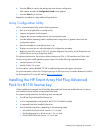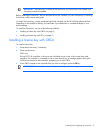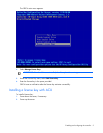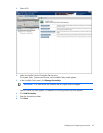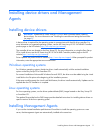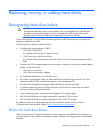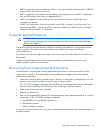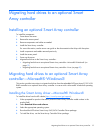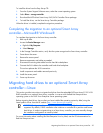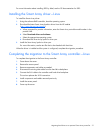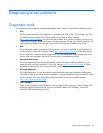Replacing, moving, or adding hard drives 15
Replacing hard drives
If you are replacing a drive in a fault-tolerant configuration while the system is powered down, a POST
message appears when the system is powered up. When this message appears, press the F1 key to
enable automatic data recovery. If you do not enable automatic data recovery, the logical volume
remains in a ready-to-recover condition, and the same POST message appears when the system is
restarted.
In RAID 1 configurations, you can replace one failed drive.
In RAID 1+0 configurations, drives are mirrored in pairs. If drives are not mirrored to removed or failed
drives, you can replace them simultaneously.
Guidelines
Before replacing hard drives, observe the following guidelines:
• Be sure that the array has a current, valid backup.
• Confirm that the replacement drive is a SATA drive.
• Use replacement drives that have a capacity equal to or greater than the smallest drive in the array.
The controller immediately fails drives that have insufficient capacity.
To replace more drives in an array than the fault tolerance method can support, follow the previous
guidelines for replacing several drives simultaneously. Wait until rebuild is complete, as indicated by
ACU/ACU-CLI, before replacing additional drives.
If you need to replace more drives than the fault tolerance method can support because fault tolerance
has been compromised, recover the data before replacing any drives. For more information, see
"Recovering from compromised fault tolerance (on page 14)."
Automatic data recovery (rebuild)
When you replace a hard drive in an array, the controller uses the fault-tolerance information on the
remaining drives in the array to reconstruct the data from the original drive and write it to the replacement
drive. This process is called automatic data recovery or rebuild. If fault tolerance is compromised, this
data cannot be reconstructed and, likely, is lost permanently.
If another drive in the array fails while fault tolerance is unavailable during rebuild, a fatal system error
can occur, and all data on the array is then lost. In exceptional cases, however, failure of another drive
does not always cause a fatal system error. These exceptions include the following:
• Failure after activation of a spare drive
• Failure of a drive that is not mirrored to any other failed drives (in a RAID 1+0 configuration)
Time required for a rebuild
The time required for a rebuild varies, depending on several factors:
• The priority that the rebuild is given over normal I/O operations
Change the priority setting with ACU ("Array Configuration Utility" on page 7).
• The amount of I/O activity during the rebuild operation
• The rotational speed of the hard drives



